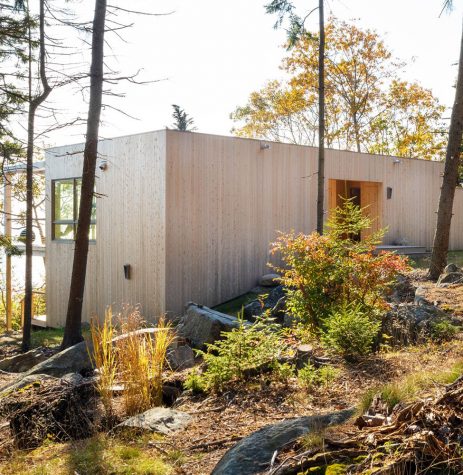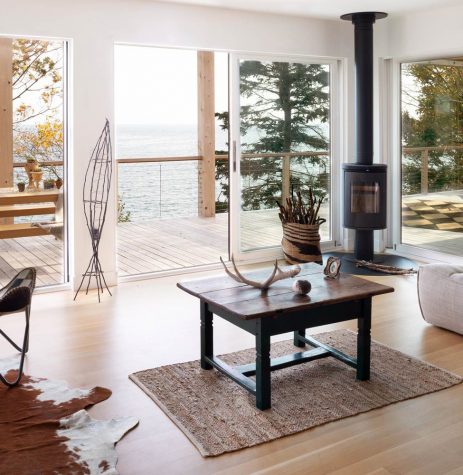Heather Thompson and Rachel Conly of Juniper Design+Build on Integrated Design
Heather Thompson and Rachel Conly spent over ten years—in Thompson’s case, 20-plus—running their separate businesses, Thompson Johnson Woodworks and Rachel Conly Design, before joining forces in early 2022 to create Juniper Design+Build, a company centered around integrated design and sustainable practices. In their interview with MH+D Inside Out, Conly and Thompson talk about their collaborative work process and how they are able to positively impact the world.
Q. What inspired you to team up and form Juniper Design+Build? What is the ethos of your work?
A. We’ve been thinking about merging our businesses for more than ten years! But this is the moment. We’re both thriving, and we’re experienced enough to know what our values are. We both love great design and share a commitment to doing top-quality work, sustainable building practices, and carbon mitigation. Plus, we both care a lot about creating great client relationships and a diverse and positive employee culture. Given that design/build brings so many advantages to either business operating separately, there’s no question this is the right move. That, and the fact that we have a lot of fun together. I mean, really, the only question is, “Why didn’t we do it sooner?”
Q. What is your collaborative process like? What makes the design/build process better than separate processes?
A. We believe in the advantages of Integrated Design, so we work in a highly collaborative way. That means the whole team is on board from the beginning of any project: builder, designer, engineer, trade subcontractors—everyone. It makes the process much more efficient, and eliminates a lot of the mistakes that can occur when people with essential expertise aren’t in the room from the beginning. Plus you get the benefit of a lot of smart people with decades of experience weighing in, so solutions really are the best they can be. We think highly of many separate architect and contractor companies. But there’s no question that design/build is a better fit for the way we work, and for what we can offer our clients.
Q. What is the most important thing to keep in mind when designing a sustainable, efficient space?
A. We’re striving to help push our industry’s environmental performance forward, so this is something that is at the core of everything we do. Minimizing a building’s carbon footprint begins with design. We use advanced thermal envelope practices throughout, with Passive House air sealing standards, extra-thick cellulose-packed walls and roofs, and triple-pane windows. Just as important: we won’t build an enormously oversized house. We encourage our clients to put their investment into the building envelope and efficiency, rather than scale, and to have a beautiful, high-quality home with a reasonable footprint.
Material choices are critical as well. We source materials locally whenever possible, and minimize the use of high-embodied carbon materials like foam and concrete. And we always use wood siding. But also—and this is sometimes overlooked—it means we build durable buildings because ultimately that’s one of the best ways to reduce environmental impact. So we sweat the details that make buildings last longer. Rain-screen systems, back-sealing all siding and trim, and detailed water-runoff management are just a few of the things we do.
Q. How would you describe your aesthetic?
A. We have an affinity for the clean lines of modern architecture, and we always emphasize bringing lots of natural light into the spaces we design, but in truth, we have no knee-jerk design approach. Our goal is to help our clients find their vision and to create with them a space that is unmistakably their own. And we’ve worked in a wide range of aesthetic languages to accomplish that.
That being said: One of the benefits of practicing a profession over many years is the confidence that comes with experience. It’s clear that our design work is getting bolder and less bound by convention. We’re excited by the possibilities of that. There’s always room to grow.
Q. What purpose do you see in your work?
A. One of the privileges of the work we do is the number of ways we can positively impact the world. We help our clients identify what is most important to them and then create a lasting, beautiful, energy-efficient home around that. That brings everything together: the very personal process of distilling our clients’ needs, the aesthetic challenge of creating something beautiful and useful, and the technical problem of minimizing carbon load while creating an enduring structure.
This is a terrifically exciting moment, as building science advances and sustainable building practices move into the mainstream. Helping to lead that transition, by educating our clients and encouraging their investment in sustainable practices, is very important to us. And just as important is creating a great work environment for our seventeen employees. You see the difference a supportive work culture makes in their lives—all of our lives—every single day.
Q. How would you describe your relationship with Maine? How does that affect your work?
A. There are a million things to appreciate about living in Maine. But speaking professionally—and this may be more of a surprise—it’s an amazing place to be. In our industry, there’s an enthusiastic network of people who are striving to do really high-quality work while pushing the envelope on sustainability. It could even be called a movement, and we’re proud to be part of it. And we’ve had great luck finding customers who care about creating a home with a responsible carbon footprint. It just seems natural that people who choose to live in such a special and beautiful place would think that way. No question, that makes Maine unique.
Q. What does the future for Juniper Design+Build look like? What are your long term goals?
A. You know, as experienced as we are, we’re ready for the next phase that Juniper Design+Build represents. We’re both able to bring decades of work experience to Juniper, as well as to our fantastic team members. And somehow working together is providing an opportunity for us to get even more intentional about the kind of relationships and impact we want to have. All indications are that Juniper will grow robustly, but that’s not primarily what we’re after. We’re all about creating a quality day in, day out worklife for our employees, a satisfying experience for our clients, and leaving a design and sustainability legacy that future generations of Mainers will be inspired by. That’s what gets us to the office every day.
Q. What does it mean to you that you’re both women in a profession typically dominated by men?
A. We both do what we do because we love doing it—end of story. But we do recognize that it’s a bit unusual, and because of that, it has a sort of the second impact. If we’re seen as somehow widening the trail for what women can comfortably do in this life, so much the better. We have our share of eyeroll stories, but we’ve created many, many remarkable relationships with all sorts of people throughout our careers. People working together, with respect, to solve complex problems is progress. If we’re a small part of that, we’re all in.






